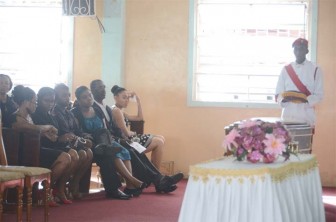Kenrick Fitzpatrick Moore MS was yesterday remembered as one of best photographers the country has ever produced and a man whose attention to detail—from the clothes on his back to every shot he took—reflected an aspiration towards excellence.
It was his attention to his appearance that almost got him into trouble when he covered the funeral of the late president Forbes Burnham. “Everyone kept staring at me and wanted to know who I was. I was attired in a mauve suit which I felt was appropriate for the occasion. What I later found out was that the particular colour was the colour of preference of the late president,” Moore was quoted as saying in an interview conducted some time ago with his wife Allison, who shared his words yesterday at his funeral service at the First Assembly of God Church on D’Urban Street. Moore, 72, passed away on Monday.

At Burnham’s funeral, Moore was followed around for some time by a member of the police special branch until it was revealed that he was just a photographer doing an honest day’s work.
Persons from all walks of life turned up to pay respects to him yesterday, including his best friend and ‘spin twin’ photographer Winston Oudkirk, Opposition Leader David Granger, former commissioner of police Laurie Lewis and Mayor Hamilton Greene.
Allison, reading the eulogy of her husband of 13 years, said he was born to parents Sydney Moore and Mabel Rawlins —the first of three children. He was student of the Bourda Roman Catholic School and continued his education at the Guyanese College of Modern Education. After school he developed a passion for photography and his first job was at the Argosy newspaper and later at the Chronicle, Graphic, Evening Post, Mirror and finally Stabroek News.
“I love photography to the core and was not mentally ready to retire!” was what Moore told his wife about his forced retirement from this newspaper due to illness.
Moore, who had migrated to the US, read for a diploma in professional photography at the School of Modern Photography in Little Falls, New Jersey and later gained employment at Time-Life Magazine where he remained for three years.
He returned to Guyana in 1985 and was running his own photo studio when this newspaper opened its doors in 1986 and was quickly employed as chief photographer. Aside from the anecdote about Burnham’s funeral Moore also recalled to his wife that he followed the police during their hunt for notorious criminal Clement Cuffy in Essequibo. It was exciting to him to overnight and he was there when Cuffy was killed in a gun battle with the riot squad. He said during his tenure as a photographer he had stored many memorable events in his memory bank including fires and floods and sadly remembered the fire that destroyed the historical Sacred Heart Church. He was first on the scene.
Moore’s work made him a few enemies and he recalled taking a photograph of a discarded cigarette pack by former president Burnham. It made news simply because it was foreign-made product at a time when Burnham was advocating that the nation only use local products.
“As I listened and concluded my interview with this great son of the soil, I could not help but admire this man. A man whose professional photographs left indelible images in the minds of many; a man who was enviously admired by friends and foes alike; a man who was loved and disliked at the same time” Mrs Moore said of her husband.
Meanwhile, Stabroek News Editor-in-Chief Anand Persaud said that Moore’s death would leave a deep void in many places, but his work will live on as the truest testimony to his brilliance. He said Moore was always perfectly “decked out and well matched from head to toe.
“It wasn’t vanity. It was the standard he set for everything he did. Excellence behind the camera required excellent preparation and excellent appearance,” Persaud said.
He added that Moore was a father figure to many and who always went out of his way to show kindness. On assignments, Persaud said, he took charge of inexperienced reporters and looked out for them and even protected them from the “hazards of unruly officials.” He also mentored many photographers who worked with the newspaper on techniques and the best imagery.
“He was the inspiration to many of them. He also brought many people into the employ of the newspaper,” Persaud said.
“He was an integral part of the newspaper’s functioning. Without him it wouldn’t have blazed a trail as it did. He was family. A cherished family member,” he said.
Rev Raphael Massiah conducted the service.





